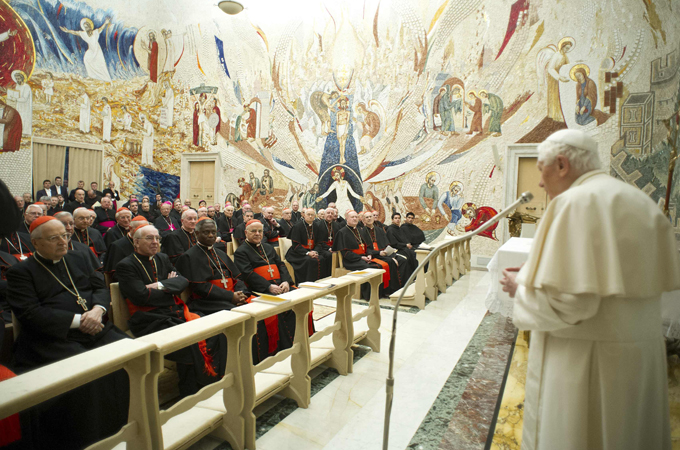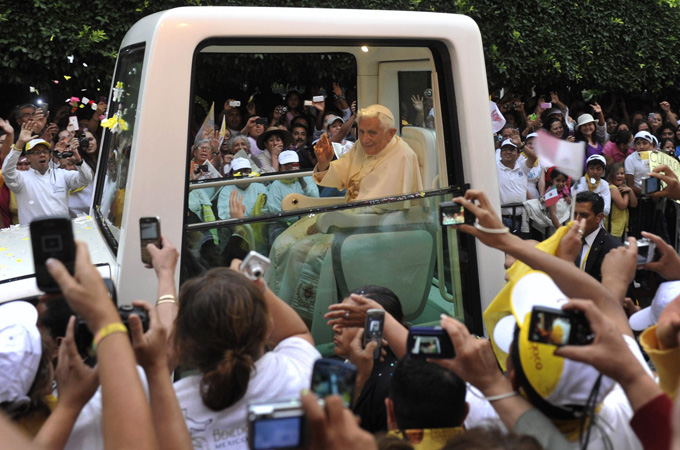His death on Saturday came days after Pope Francis had asked for prayers for his predecessor, saying he was “very sick”.
The Holy See Press Office said Benedict died in his residence at the Mater Ecclesiae monastery, which he had chosen as his residence after resigning in 2013.
‘We have a Pope’
“Annuntio vobis gaudium magnum: Habemus Papam! … I announce to you a great joy: We have a Pope!”
These famous words were uttered on April 19, 2005, after the conclave elected Ratzinger pontifex maximus, the pope.
Born in Germany and raised in Bavaria, he would henceforth be known as Benedict XVI.
The conclave’s choice was the next logical step considering Ratzinger’s path. A life dedicated to God and the Catholic Church.
From chaplain to pope
After the Second World War, he first studied theology and philosophy and laid the foundation for what was to come when he became a chaplain in Munich in 1951.
Ratzinger then made a name for himself as an academic. First, he obtained a doctorate, then became a professor at the University of Bonn with his inaugural lecture on “the God of Faith and the God of Philosophy”.
In 1966, he became the chair for dogmatic theology at the University of Tübingen, the continuation of an impressive academic career. But his devotion to religion did not end at the universities.
While his writings gave him a profile, the papacy was still not on the horizon. However, Ratzinger also posed the dedication to progress.
“He started to build his credentials with the Vatican first with Paul VI, who made him cardinal and then with John Paul II, who made him the most important adviser, close to him in Rome, for almost a quarter of a century,” Massimo Faggioli, a professor of historical theology at Villanova University, told Al Jazeera.
Indeed, on March 24, 1977, at age 50, he was appointed the archbishop of Munich-Freising, before being named cardinal priest of Santa Maria Consolatrice al Tiburtino by Pope Paul VI in the consistory of June 27 1977.
‘Moral truths’
Four years later, in 1981, Pope John Paul II called Ratzinger to Rome, where he became the prefect of the Sacred Congregation for the Doctrine of the Faith, the oldest among the departments of the Roman Curia.
Ratzinger was henceforth Pope John Paul II’s right-hand man. What the Pope proclaimed, Ratzinger underpinned theologically.
When Pope John Paul II passed away, the connection Ratzinger had built with the latter and the numerous other relationships he had championed within the Vatican became of great value.
“Their two pontificates are part of one same long 35-year long period. In the conclave of 2005, the cardinals knew it, and his election was the choice to confirm the direction John Paul II had given to the church since 1978,” Faggioli said.
Ratzinger was considered by many to be one of the most important theologians of our time who knew the Vatican inside out, including processes, institutions, people and machinations of the Curia. He possessed all the prerequisites for a successful pontificate.
“Benedict XVI’s greatest contribution to the Catholic Church through his encyclicals ‘Deus caritas est’ (God is Love), ‘Spe Salvi’ (Saved by Hope) and ‘Caritas in veritate’ (Love or Charity in Truth), and other pronouncements such as ‘Sacramentum caritatis’ (The sacrament of charity), has been his insistence on the Church’s teaching about moral truths – that ethical decisions are based on an objective morality, rather than at the mercy of subjective, chimerical beliefs which he has labelled ‘the Dictatorship of Relativism’,” Rebecca Rist, a professor of medieval history at the University of Reading, told Al Jazeera.
“He has emphasised that Christianity is the ‘religion of the Logos [reason]’ but which he meant that faith comes from ‘creative reason’ and is ‘open to all that is truly rational’,” Rist added.

Moreover, during his tenure, Benedict XVI established himself as a pope who could and would reach people outside of dogmata and the clandestine nature of the Vatican.
“He was a churchman who could extend his influence over and beyond the Vatican in different circles and audiences. He was not afraid to be unpopular and understood the crisis of naive liberal-progressive Catholic culture,” Faggioli said.
“He was a policy maker but also knew how to select a new kind of Catholic bishops, and his books and essays translated in many languages reached many in ways that were not typical of a cardinal and more of a public intellectual,” he added.
Lack of structural reform
Benedict XVI also ushered in significant changes during his papacy.
Rist said he increased the number and speed of beatifications and canonisations, allowed the celebration of the Tridentine (Latin) Mass which had lapsed in popularity after Vatican II (1962-1965) and enabled some curial reforms such as the creation of the Pontifical Council for the Promotion of the New Evangelisation.
Benedict also began the process of addressing widespread sexual abuse and paedophilia among the clergy, as well as initiated sometimes controversial inter-faith dialogue with Christian sister churches such as the Greek Orthodox Church, the Anglican Church, and other leading faiths such as Judaism, Islam, Buddhism and Hinduism, she added.
On the other hand, Benedict XVI failed to usher in a much-needed paradigm shift within the Catholic Church and the papacy.
“He was unsuccessful in recasting the papacy so that a pope could avoid being the spokesman for a post-European, global Catholic Church and for inter-religious dialogue, a posture since embraced and embodied by Francis,” Faggioli said.
Moreover, while he tightened the rules for dealing with cases of sexual violence worldwide and in the curia, critics noted that he never addressed the deeper causes of the violence, which are to be found in the structures of the church, despite all genuine remorse.
“Ratzinger did not work to bring about the canonical and theological change that the sexual-abuse crisis made painfully and clearly necessary; instead, he continued to view the scandal through the lens of the post-1968 culture war. And he never made a real attempt at reforming the Vatican and the central government of the Catholic Church,” Faggioli said.

Other points of criticism are his “naivety and frailty in dealing with financial and structural problems within the Roman Curia”, Rist said.
“Critics argue that he only touched the surface in cleaning up financial irregularities and abuses, as in the case of the Vati-Leaks scandal in 2012 which involved the leaking of documents by his butler, Paolo Gabriele, and exposed power struggles and faction fighting in the Vatican,” she added.
“It has been suggested that it was Benedict’s realisation that he was physically and mentally unable to deal with such corruption which confirmed his decision to resign the papal office in 2013,” Rist said.
However, no matter how history will judge Benedict XVI, no matter the missed opportunities and the internal disputes within the Catholic Church, the legacy he now left behind, as a scholar and as a pope, is immense, experts believe.
“Benedict’s outstanding qualities as pope have been as an intellectual, academic, theologian and teacher,” Rist said.
“He belongs to a separate class in terms of influence, different from any other churchman in the last 50 years,” Faggioli concluded.
